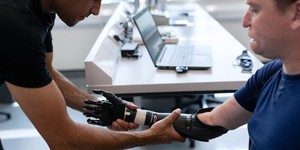Modeling the Human Cardiovascular System: The Factors That Affect Blood Flow Rate
Abstract
People often call cardiovascular disease a "silent killer." This disease sneaks up and causes damage, but patients don't realize it—until serious symptoms start. That is why physicians recommend keeping your cardiovascular system healthy. A healthy cardiovascular system gives us the energy and the stamina to do all of the things that we want to accomplish, such as do our best in school and perform well in sports. But what makes a cardiovascular system unhealthy, and what are the factors that lead to problems like poor blood flow rate? In this life science project, you will build a model of the heart and the arteries with a bucket, tubes, and water to see what affects blood (water) flow rate. You will see what it takes to maintain a healthy heart and arteries.Summary
Michelle Maranowski, PhD, Science Buddies
Edited by Colleen Callaghan, MD
This science project idea is based on this 2010 California State Science Fair entry: Balasingam, Namrata. (2010). On the Rate of Flow of Liquids in Tubes and Its Implications to Cardiovascular Health.
Objective
Build a model of the human cardiovascular system, and investigate the effect of changing the diameter of an artery, due to disease, on blood flow rate.
Introduction
The human body is made up of several systems that work together to keep the body functioning properly. One of these systems is called the cardiovascular system. The job of the cardiovascular system is to move blood, which contains oxygen and nutrients, throughout the body to the different organs and the brain. The cardiovascular system is made up of the heart, arteries, capillaries, and veins. For the purpose of this project, let us focus on the heart and arteries.
The heart is a muscle that acts as the pump of the cardiovascular system. The heart is divided into the right and the left sides. Each side has two chambers, an atrium and a ventricle. The right side of the heart pumps oxygen-poor blood to the lungs where the lungs deliver oxygen to the blood. The oxygen-rich blood comes back to the left side of the heart into the left atrium and empties into the left ventricle. From there, the heart pumps the blood through the aorta, the largest artery in the body, to supply the organs and the brain with oxygen and other nutrients. Valves separate the atrium and ventricle on each side of the heart. The valves make sure to keep the blood flowing in the right direction. Because the right side and the left side of the heart are not connected, the oxygen-poor blood does not mix with the oxygen-rich blood. The heart muscle itself also needs oxygen to function properly. A network of coronary arteries covers the heart and provides it with oxygenated blood. Watch this video to understand the details of how the heart works.
A healthy cardiovascular system is very important to maintain good health. Failing to maintain good cardiovascular health can result in heart disease or atherosclerosis. In atherosclerosis, cholesterol, fatty substances, calcium, and other substances start to build up in the inner lining of an artery. This buildup, called plaque, leads to a narrowing (smaller diameter) of the artery. If a plaque breaks, it can cause a blood clot to start. A blood clot can block blood flow or can travel to a different part of the body. Depending on where the clot occurs, it can cause a heart attack or a stroke. A heart attack or stroke is a very dangerous health problem, but even plaque that stays put can cause issues by contributing to poor blood flow. Poor blood flow can cause chest pains, high blood pressure, shortness of breath during light exercise, leg pain, and loss of oxygen to the brain.
In this life science project, you will make a model of the cardiovascular system and investigate if plaque or narrowing in the arteries affects flow rate. You will make the model with a bucket, valves, and vinyl tubing of different diameters. Does the flow rate depend on the diameter of the tubing? If so, how much does the flow rate change?
Terms and Concepts
- Cardiovascular
- Artery
- Capillary
- Vein
- Muscle
- Pump
- Atrium
- Ventricle
- Aorta
- Coronary
- Atherosclerosis
- Plaque
- Blood clot
- Absolute value
- Magnitude
- Density
- Hagen-Poiseuille equation
Questions
- What causes your heart to beat?
- What are the four different heart valves?
- What can happen to your brain if blood doesn't flow to it?
- What happens to your body during a heart attack?
- What is plaque made of?
- What can happen to your legs if there isn't enough blood flow to them?
Bibliography
These websites offer more information about the cardiovascular system and blood flow rate:
- Klabunde, R.E. (2010). Cardiovascular Physiology Concepts: Peripheral Arterial Occlusive Disease. Retrieved February 1, 2011.
- Mayo Clinic Staff. (2011, January 12). Heart Disease: Causes. Retrieved January 26, 2011.
- The Nemours Foundation. (2011). Teens Health: About the Cardiovascular System. Retrieved January 28, 2011.
Watch these videos to understand how the heart functions and to learn about the different parts of the heart:
- Alters, S. and Alters, B. (2006). Blood Flow Through the Human Heart. Biology: Understanding Life. Sumanas Inc. Retrieved January 26, 2011.
- Mayo Clinic Staff. (2009, August 7). Heart and Circulatory System—How They Work. Retrieved February 1, 2011.
This site has a library of medical videos. Watch the videos Atherosclerosis, the Cardiovascular System, and Blood Flow for more information:
- MedlinePlus. (2011). Anatomy Videos. A.D.A.M, Inc. Retrieved February 1, 2011.
Materials and Equipment
- Plastic bucket, 5 gal with straight sides
- Drill with 1/4 inch bit and 3/8 inch bit
- Safety goggles
- Plastic Quick-Connect stop valve, straight male, 1/4 inch. You can purchase a valve at your local hardware store.
- Plastic Quick-Connect stop valve, straight male, 3/8 inch. You can purchase a valve at your local hardware store.
- Plumber's putty
- Tubing, vinyl, 1/4 inch diameter, 2 foot length. The vinyl tubing must fit into the 1/4 inch valve. You can purchase vinyl tubing at your local hardware store.
- Tubing, vinyl, 3/8 inch diameter, 2 foot length. The vinyl tubing must fit into the 3/8 inch valve. You can purchase vinyl tubing at your local hardware store.
- Utility knife
- Measuring cup, 1 cup volume
- Permanent ink marker
- Stopwatch
- Location with a table
- Two additional tables (optional)
- High definition video camera (optional)
- Tripod (optional)
- Lab notebook
- Graph paper
Experimental Procedure
Building the Model of the Circulatory System
- Drill two holes in the bucket. Place each hole 3 inches from the bottom of the bucket. Drill the holes
on opposite sides of the bucket from each other.
- Use goggles and ask an adult for help when drilling holes in the bucket.
- Drill the first hole with the 1/4 inch bit.
- Drill the second hole with the 3/8 inch bit.
- Insert and screw the threaded male end of the 1/4 inch valve into the 1/4 inch hole in the bucket.
- Insert and screw the threaded male end of the 3/8 inch valve into the 3/8 inch hole on the other side of the bucket.
- Make sure that the valves are all shut, and then, test to make sure that the valves are not leaking. Fill the bucket with water to a level above the height of the valves. If they are leaking, then use some plumber's putty to seal the leak on the outside of the bucket.
- Cut two lengths of tubing with the utility knife. Cut 2 feet of 1/4 inch diameter tubing, and insert it into the free end of the 1/4 inch valve.
- Repeat step 5 with the 3/8 inch vinyl tubing and the 3/8 inch valves.
- The model is now complete. Leak test the finished model as in step 4. Once the model is leak free, proceed to the next section and start experimenting.
Experimenting with the Circulatory Model
- Fill the bucket with water to a level that is above the valves. Mark the level of the water on the outside of the bucket with a permanent ink marker.
- Place the model on the table. Ask an adult for help if the bucket is too heavy. Set the bucket so that the 1/4 inch valve and tubing is over the edge of the table. Place the tubing in the measuring cup. If you can't place the measuring cup on the floor without making a puddle, place it on a second table that is lower than the one that the bucket is on. Make sure that the tubing hangs straight down and doesn't get angled or pinched.
- If you have a video camera, place it on a table (or tripod) facing the measuring cup. The camera should be close enough that you are able to read the markings on the measuring cup.
- When you are ready to start experimenting, turn on the camera.
- Now open the valve and start the stopwatch. When the measuring cup is filled with a 1/2 cup of water, turn off the stopwatch and the valve. Record the time in your lab notebook along with the amount of water in the measuring cup.
- Repeat step 5 four more times (four more trials for a total of five trials). Refill to the original fill line each time. It is important to repeat your experiments to ensure that your results are reproducible and accurate.
- Turn off the camera. Clean up any excess water and pour the water from the measuring cup back into the bucket. Refill the bucket, if necessary, to the mark on the bucket.
- Turn the bucket so that the 3/8 inch valve and tubing is over the edge of the table.
- Repeat steps 3–7 with the 3/8 inch valve and tubing.
- Empty the bucket.
Analyzing Your Data
- Now calculate the flow rate for each trial of each diameter of tubing. Calculate the flow rate by
dividing the volume of water in the cup, 1/2 cup, by the time it took in seconds to fill the measuring
cup to a 1/2 cup. If you used a video camera to film the experiment you can watch the video to get a
precise time of when the 1/2 cup was filled.
- Figure out how to move frame by frame to retrieve a precise time measurement.
- Plot your data on a scatter plot. Can you see any trends in your data?
- Average the data for each diameter of tubing. Calculate the percent difference in flow rate between the different diameters of tubing. Equation 1 describes how to calculate the percentage difference in flow rate. Absolute value takes the magnitude of a number. For example, the absolute value of -6 is 6.
Equation 1.
| Percent difference (%) = | absolute value |flowrateA - flowrateB| flowrateA |
× 100 |
| flowrateA= flow rate at the 3/8 inch valve | ||
| flowrateB= flow rate at the 1/4 inch valve |
- Based on your results, how does a narrowed vessel affect the flow rate of blood? What are the implications for cardiovascular health?
Ask an Expert
Global Connections
The United Nations Sustainable Development Goals (UNSDGs) are a blueprint to achieve a better and more sustainable future for all.
Variations
- Does blood pressure affect the flow rate? Experiment with this variable by changing the starting level of the water in the bucket. The pressure at the valve is equal to the density of water multiplied by the difference in height between the surface of the water and the valve.
- Does the length of the tubing affect flow rate? Experiment with two additional lengths of tubing for both valves.
- Looking at your results as a whole, can you confirm whether the Hagen-Poiseuille equation is satisfied?
Careers
If you like this project, you might enjoy exploring these related careers:















